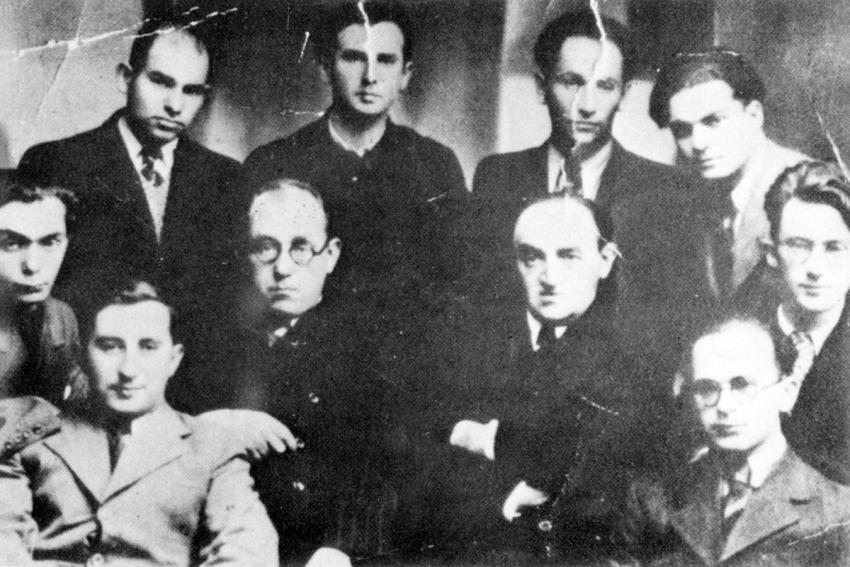
The "Young Vilna" group meets Yiddish author Joseph Opatoshu. Vilna, 1935
Yad Vashem Photo Archives 3479/126
Courtesy of Simon Wiesenthal Center
The Writers and Painters Group, "Jung Vilne"
In 1929, a group of young creators, mostly poets and some writers, painters and sculptors, formed in Vilna. Most of them came from a low-income background. They made a living from their handiwork, which expressed in Yiddish the distress of the impoverished neighbourhoods and their desire for a socialist revolution. The group met in the home of Shlomo Beilis, who published communist poetry in a New York newspaper. Some of them moved to the Soviet Union or Eretz Israel, but continued to create new works, which they often sent for publication in Vilna. They were assisted by the editors of the Tag, Zalman Reisin and Falk Heilpern. Most of the group's members were murdered during the Holocaust. A small number emigrated afterwards to the US or to Israel. Members of the group included:
The poet Abraham Sutzkever, who came from a traditional home and studied at a Polish-Jewish high school. He was a member of the Yiddish Scout movement "Bin." At first, Sutzkever was not accepted into the group because its members did not recognize a strong enough call for a workers' revolution in his work;
The poet and writer , a student in the yeshiva of Rebbe Hayim Ozer Grodzenski, who also learned for a number of years with the "Chazon Ish" (Avrohom Yeshaya Karelitz). His first poems were published in the weekly bulletin of the Yeshiva (Talmudic college) Council, and later – in Vilna, Warsaw and in "Zukunft" in the US. During the Holocaust, Grade fled to the USSR, and after the war emigrated to the US. He wrote a number of novels that won acknowledgement as ethnographic testimony, some of which were translated to Hebrew.
The poet and editor Shmerke Kaczerginski, a Talmud Torah graduate, wrote little but was a chief editor of the group's writings. He was attracted to communism, a leaning that almost led to his arrest by the authorities.
Shimshon (Siomka) Kahn, born in the townlet of Troki next to Vilna, grew up next to a gypsy camp and later translated their poetry, as well as poetry in Polish, Belarusian and German. He published poetry, skits and theatre reviews in the Tag newspaper.
Media
Vilna had two daily newspapers that were published almost continuously during the period of independent Polish rule. Tag (Day), the Yiddish-speakers’ newspaper, appeared until the Soviet occupation of Vilna during WWII. For reasons of censure, the newspaper often changed its name, but the word Tag always remained. For most of this period, the newspaper’s editor was Zalman Reisin. Bund members and undercover communists worked on the editorial board. Reisin was hostile to Zionism, but supported Territorialism. In the literary weekend supplement, he promoted the city’s writers and poets, and published Polish newspaper reviews and articles about theatre and other local issues. He also published a Zionist daily in Yiddish, Jüdische Zeitung (Jewish Times) to Unsere Freund (Our Friend) to Zeit (Time).
Other dailies appeared from time to time, such as the evening commercial paper Avant Courier - which dealt mostly with crime, disturbing family issues, suicides and murders - the government-supporting paper Unsere Stimme, editions of Warsaw papers, and others.
Party political, literary and professional journals in both Yiddish and Hebrew were published in Vilna. Most of them lasted less than a year. Many were dedicated to literature and art. Between 1929 and 1930, the Hebrew magazine Galim (Waves) appeared, and included in its content articles from Eretz Israel. The writers' group that concentrated around Galim established the "Hebrew Writers Association." Galim also organized two balls, in which the poet Itzhak Katzenelson participated. After Galim was closed, the Zramim (Currents) magazine appeared, in which the poet Uriel Akavia, the author S. Ben-Zion, the historian Prof. Joseph Klausner, K. Bertini, Yisrael Heilprin and others were contributors. Zramim operated for about nine months, and brought out 18 editions. The Yeshiva (Talmudic college) Council in Vilna, headed by Hayim Ozer Grodzenski, published the weekly Das Wort (The Word), the voice of "Agudath Yisrael," between 1924 and 1938.
A number of socialist weeklies were circulated in Vilna, including Baginen (At Dawn), published between 1932 and 1937. The Democratic Party brought out its own magazine, which discussed the territorialist ambitions of the secular Yiddishists. Two Yiddish communist weeklies were closed by the authorities in 1937. In 1932, a trial publication of a weekly brought out every Sabbath was closed due to a protest by the "Guardians of the Sabbath" Society.
"The Society of Jewish Writers and Journalists" dealt with the publication of books on culture, literature and history, the commemoration of spiritual leaders and evening discourses on literature, theatre and art. These evenings included a public gathering in honour of writers that visited the city. The society also maintained a loan fund, a fund for the infirm, and a pension fund. The author of its regulations and first chairman was S. Ansky. In 1921, marking the end of the 30-day mourning period since the murder of Yosef Haim Brenner in Jaffa, a memorial evening was held at the people's university founded by "Tarbut." They joined protests over the 1929 riots in Eretz Israel, and in 1937 sent a representative to the World Congress for Yiddish Culture (Yiddisher Kultur Farband - YIKUF) that gathered in Paris. The society declared the struggle against the "Shund" – novels and other publications considered a step down in quality – and published a list of recommended novels and books for reading and purchase. The list was distributed for free, in large numbers.
